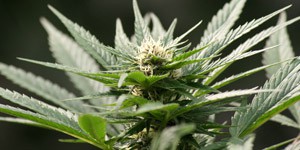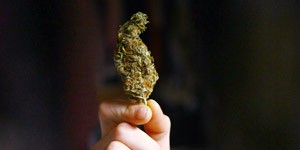By Luis David Suarez Rodriguez

UNAM graduate physician with clinical Specialization in Acupuncture and
Phytotherapy and Medicine of Physiological Regulation.
He is a member of several national and international scientific associations for functional medicine and ozone therapy. He has been practicing functional medicine for more than 12 years and has been working with medical cannabis in his private practice for 8 years. He has been a member of the International Association of Cannabinoid Medicines (IACM) since 2015. In 2018, together with other health professionals, he founded the Mexican Association of Cannabinoid Medicine (AMMCann AC), a non-profit institution whose objectives are the education of doctors and other health professionals on the correct use of cannabinoid medicine in Mexico. He is currently its President.
Specialist in Endocannabinology who graduated from the DIECC of the National University of Rosario, Argentina. He is the academic coordinator of the first International Diploma in Endocannabinology at PUIS-UNAM.
He is the author of several scientific articles on functional medicine and cannabinoid-based medicine and gives courses and lectures on these topics in national and international forums.
"I can't sleep, Doctor. I started taking CBD (Cannabidiol) for my insomnia on the recommendation of a family member about two months ago. At the time it worked wonders for me, but now it doesn't work so well. Can you help me?"
This is a question often heard in the office of a Cannabinoid Medicine specialist. Cannabis has been recognized since antiquity for its sedative and hypnotic effects, and today sleep disorders are one of the commonest reasons why many people seek and recommend taking cannabinoids.
But its use raises questions, such as: How effective are they? Can they be used long-term? What adverse effects can they have? Can they be combined with other treatments? Can they replace commonly-used drugs for insomnia?
These are just some of the questions that patients ask. Honestly, as doctors, we do not yet have all the answers. This is to be expected when it comes to understanding the functioning of the endocannabinoid system and its interaction with molecules derived from the cannabis plant. However, science helps us to understand how, when, and why cannabinoids can help us sleep better.
Let's start with the fact that cannabinoids work by interacting with our endocannabinoid system (ECS), a complex system of intercellular communication that could be considered a "master homeostatic system" as it is distributed throughout the human body, including the brain, the immune system, and virtually all peripheral organs and tissues. The ECS is known to be composed of endocannabinoid molecules, receptors to which cannabinoids bind and through which they exert their different effects, and of the enzymes that regulate the production and degradation of these endocannabinoids.
Sleep is an essential physiological function that alternates with wakefulness. Broadly speaking, sleep has been found to be organized into two alternating phases: the non-rapid eye movement phase (non-REM) and the rapid eye movement phase (REM). The regulation of the sleep-wake cycle is a complex interplay between several neuroanatomical and neurochemical systems including, of course, the endocannabinoid system.
The REM phase is regulated by neurons in the pons and hypothalamus and is also promoted and maintained by cholinergic neurons located in the dorsolateral pons. Non-REM sleep is regulated by neurons in the pre-optic area, such as those in the ventrolateral preoptic nucleus, which inhibit the ascending activating systems. These sleep-promoting regions of the brain are mainly regulated by inhibitory neurotransmitters such as gamma-aminobutyric acid (GABA) or galanin. Wakefulness, conversely, is mediated primarily by neurons located in the rostral half of the reticular formation that project to areas of the thalamus, hypothalamus, and forebrain. The main neurotransmitters involved in promoting wakefulness are monoamines (dopamine and serotonin), acetylcholine, and the orexin-hypocretin system. The endocannabinoid system is closely linked to circadian rhythms governing the sleep-wake cycle, as levels of endocannabinoids – especially anandamide and 2-AG – have been shown to fluctuate throughout the day. Anandamide levels tend to be highest during the dark phase (night), while 2-AG levels increase during the light phase (day). Activation of CB1 receptors in the aforementioned areas of the brain, which are responsible for promoting relaxation and reducing neuronal activity, may contribute to sleep induction. Studies have suggested that the administration of endocannabinoids such as anandamide and 2-AG, and the inhibition of enzymes that break them down, can induce drowsiness. This effect is thought to be mainly associated with non-REM sleep, including slow-wave sleep, which is essential for memory consolidation and restoration. Non-REM sleep is also characterized by reduced neuronal activity and bodily relaxation. The activation of CB1 receptors by endocannabinoids probably contributes to this general regulation of neuronal activity, promoting the transition to non-REM sleep.
The endocannabinoid system also appears to influence sleep patterns, including the distribution and duration of different stages of sleep throughout the night. By modulating the activity of neural circuits and the release of neurotransmitters, cannabinoids may affect the balance between light and deep sleep, as well as the occurrence of REM sleep. In addition to the observed changes in neurological activity, sleep shows dynamic fluctuations involving the cardiovascular, autonomic, respiratory, and endocrine systems, in the regulation of which the ECS is, of course, also involved.
For example, in some clinical trials on the use of cannabinoids for treating other conditions, such as chronic pain, post-traumatic stress disorder, or generalized anxiety disorder, an improvement in the insomnia associated with these conditions was observed, and patients could achieve deeper, longer sleep. However, after a while some start to show changes in sleep patterns: if they only use isolated cannabidiol (CBD) they may soon develop insomnia, as CBD lacks the sedative effects of tetrahydrocannabinol (THC). Therefore, these patients slept better because they were more relaxed – CBD is an excellent anxiolytic – but not because CBD induced sleep. If we continue with this hypothetical patient, when she reports that CBD alone is no longer helping her sleep, the normal course of action would be to start her on a low dose of THC together with CBD, after which we may see further positive effects against insomnia. However, the sedative effect of THC often creates tolerance, so the pharmacological strategy would be to gradually increase the amount of cannabinoid (THC) until the patient can sleep again. But here we run into another problem: chronic THC use has been found to reduce slow-wave sleep and increase wakefulness, so above a certain threshold that is not clearly known and varies from one individual to another, this combination of CBD-THC will no longer help our patient to sleep, and may now even present adverse effects due to high doses of THC, such as anxiety, paranoia, and even panic attacks, tachycardia, cold sweats, etc.. Therefore, long-term use is not justified, and nor is the use of high doses of THC.
However, there are other molecules in the cannabis plant that have hypnotic and sedative effects too, such as CBN (cannabinol) or terpenes like myrcene and linalool. Again, we lack sufficient evidence in the form of clinical trials on its safety and efficacy in the treatment of sleep disorders. Perhaps this is where doctors should take users more into account, because – for a change – the anecdotal evidence (real world evidence) about cannabis – i.e. the testimony of thousands of cannabis users – contradicts science. Those who use cannabis recreationally (smoked, vaporized, or in edible form) report that they can fall asleep and stay asleep. Perhaps it is a matter of the strain of cannabis consumed, or, in other words, the cannabinoid and terpene profile of those strains. Terpenes are known to have a variety of biological effects and their presence in cannabis may contribute to the overall medicinal properties of the plant. Myrcene and linalool are just two examples of terpenes that have shown promising effects in the treatment of various conditions, particularly insomnia and sleep disorders. This synergistic effect between different components of cannabis, known as the entourage effect, raises important questions about the interaction between different cannabis compounds. While recent evidence from controlled clinical trials suggests that this effect may not be as crucial as previously believed, this area still requires further exploration, especially given the contradictory results we see in clinical studies or as anecdotal evidence. Understanding how the different compounds in cannabis work together, or can potentially counteract each other, is crucial to developing targeted, effective treatments.
Within cannabis lore, Indica cannabis strains are considered to have more sedative terpene profiles and Sativa more stimulating profiles. A recent study (4) analyzed subjective data (i.e. self-reported perception of effects) from people who used cannabis to control insomnia symptoms. The findings they report are very interesting: according to users, indica strains were most used for insomnia, while sativa strains were used less frequently. The study also recognized variations in THC and CBD content between different strains and included a category of products in which CBD is predominant. The study examined the frequencies of forms and methods of ingestion of cannabis products in different age groups and genders. Vaping was the most popular method of ingestion among all groups. What is very interesting is that cannabis products were found to be significantly effective in reducing insomnia, regardless of gender, age, or time of day of use. Indica and indica-dominant hybrid strains were found to be more effective in controlling insomnia compared to CBD-dominant and/or sativa-dominant strains. The authors acknowledged that the effectiveness of cannabis products may be due to pharmacological effects and response expectancy effects. The study suggests that future research should explore the effects of terpenes and cannabinoids on perceived efficacy and highlights the importance of truly understanding the entourage effect and accurately classifying cannabis products according to their chemical composition, or chemotype.
Cannabinoids have also shown potential in the treatment of some sleep-related conditions, such as sleep apnea and restless legs syndrome (RLS). Sleep apnea is a disorder characterized by interrupted breathing during sleep, resulting in fragmented sleep and excessive daytime sleepiness. RLS, conversely, is a neurological disorder causing an irresistible urge to move the legs, often disrupting sleep. Research suggests that cannabinoids, specifically THC (tetrahydrocannabinol) and CBD (cannabidiol), may have therapeutic effects on both sleep apnea and RLS. THC has been found to reduce the frequency of apneas (pauses in breathing) and improve overall sleep quality in people with sleep apnea. CBD, however, has shown promise in alleviating the symptoms of RLS, such as the irresistible urge to move the legs and the accompanying unpleasant sensations.
Regular cannabis users who stop using cannabis deserve a separate mention, as the main symptom of withdrawal in the cannabis-dependent is insomnia, characterized by difficulty in falling and staying asleep, which can last for several weeks or months after ceasing use. In any case, this fact shows how important a well-balanced, healthy ECS is for falling and staying asleep.
So, are cannabinoids useful for treating sleep disorders, or not?
The answer is yes, if they are taken with care and with an awareness of the potential risks and expected benefits. Thus, it is crucial to discuss strategies to avoid the development of tolerance to cannabinoids with the physician, such as combining cannabinoids with low doses of melatonin or other hypnotics, stopping treatment for a week every eight to twelve weeks to allow the ECS to revert to normal, incorporating other sleep-inducing strategies such as meditation and exercise, avoiding caffeine and other stimulant intake after midday, reviewing habits and behaviors around bedtime – for example, avoiding blue light from electronic screens for at least one hour before bedtime – and so on. As in any treatment involving the ECS, diet is a crucial aspect to consider. It should always be rich in healthy fats, and pre- and probiotics, as the ECS is also involved in the regulation of the microbiota, in a complex dance with many lipid-signaling molecules such as palmitoyl-ethanol-amide (PEA), oethyl-ethanol-amide (OEA), and many others that compose what we now call the Endocannabinoidome.
In conclusion, scientific research on the endocannabinoid system and sleep regulation suggests that cannabinoids may have positive effects in the short and medium term, but that chronic cannabis use may negatively affect long term sleep quality. Although cannabinoids show promise in the treatment of insomnia, RLS, and other sleep disorders, more research is needed to determine their efficacy and safety. As always, it is important to talk to a doctor before using cannabinoids to treat any symptoms, and to explore other treatment options.
Bibliography
1. Kaul, M., Zee, P.C. & Sahni, A.S. Effects of Cannabinoids on Sleep and their Therapeutic Potential for Sleep Disorders. Neurotherapeutics 18, 217–227 (2021). https://doi.org/10.1007/s13311-021-01013-w
2. Viola Brugnatelli, Mres; Fabio Turco, PhD. Principles of Clinical Cannabinology. A Comprehensive Guide to Medical Cannabis in Europe. CannabiScientia. Prohibition Partners. 2023. pp 54-66
3. Tomkiewicz, M., Tomkiewicz, J., et. al. (2023). CBD and THC - influence on insomnia, sleep apnea and restless leg syndrome - review based on recent advances. Journal of Education, Health and Sport, 13(3), 320–330. https://doi.org/10.12775/JEHS.2023.13.03.041
4. Kuhathasan N, Minuzzi L, MacKillop J, Frey BN. The Use of Cannabinoids for Insomnia in Daily Life: Naturalistic Study. J Med Internet Res. 2021 Oct 27;23(10):e25730. doi: 10.2196/25730. PMID: 34704957; PMCID: PMC8581757.
5. Weston-Green Katrina, Clunas Helen, Jimenez Naranjo Carlos. Review of the Potential Use of Pinene and Linalool as Terpene-Based Medicines for Brain Health: Discovering Novel Therapeutics in the Flavours and Fragrances of Cannabis. Frontiers in Psychiatry. (12) 2021. https://www.frontiersin.org/articles/10.3389/fpsyt.2021.583211 DOI=10.3389/fpsyt.2021.583211


